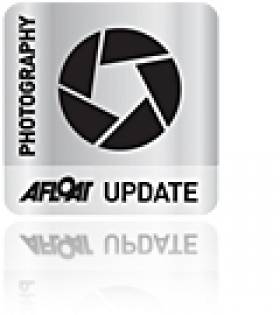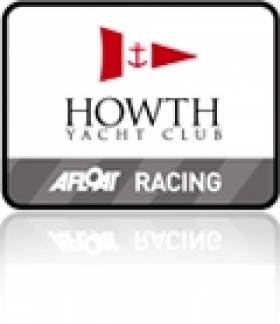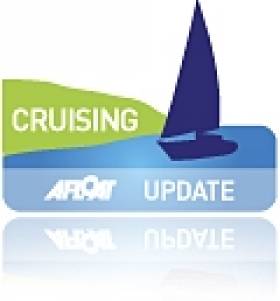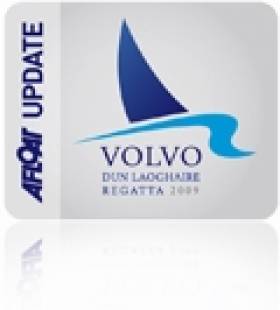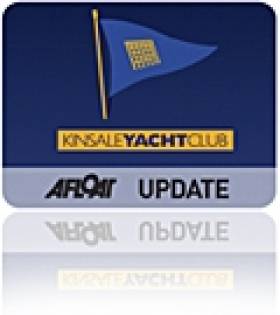Displaying items by tag: Club
Kinsale Spring Sailing Photos
Bob Bateman was afloat today to capture the latest Spring sailing off Kinsale Yacht Club, a month long sailing series that has been sailed in sunshine so far each Sunday and today's Bank holiday Monday race was no different. Scroll down for photos, there are some nice shots of John Twomey's Sonar, Shillelagh.
Today's racing was sailed in a north east 8 knot breeze. An ebb tide flowing out of Kinsale harbour gave a good beat on the windward/leeward course, leaders tacking up the western shore.
The first round the weather mark was Anchor sailed by Ian Travers with sailmaker Nigel Young on board.
Winds dropped during the day but filled in again from the South East.
Classes 0, 1, 2 were on a round the cans course taking the Bullman buoy as weather mark before going on a two sail reach to Sovereigns Islands and a run out to SE mark.
Racing co ntinued all day and a weary class 2 only returned to the harbour after 5pm.
Racing concludes next saturday followed by a prize giving Dinner.
Howth Yacht Club Lays Out 2011 Sailing Programme
At a launch reception in the club on Thursday 31st March attended by representatives of local commerce, tourism and community bodies, HYC Commodore Roger Cagney announced that in addition to junior and adult sail training courses and club racing four days a week in the summer months, the Club would host over 20 open events during the year.
"We are used to sailing being a year-round activity," he said, "but even by our standards this will be an exceptionally busy year for Howth Yacht Club. We are fortunate in the number of talented volunteers we can call upon to help make these events successful and we have an enviable track record in this regard. We are also extremely grateful for the sponsorship of individual events from commercial concerns, details of which will be released in due course."
The major event on the 2011 calendar is undoubtedly the European Championship of the J24 Class, the world's most popular racing keelboat, when over 200 sailors from six or more countries will compete in the four-day regatta in September.
Howth will also host the Irish Championships of four classes – Puppeteer, Squib, Howth 17 and Optimist – between July 1st and late-August, with the latter attracting up to 200 competitors, together with their families, coaches and supporters. In addition, HYC will run the SB3 Eastern Championships (end April), the RS Feva Leinsters (late May) and the Dublin Match Racing Open (in J80s in early September).
The club's programme also comprises the Spring Warmer series in April, the annual Lambay Races on June 11th, the Dinghy Regatta a week later and the ever-popular Autumn League over five weekends in September/October.
Irish Cruising Club Present Fastnet Award to Killian Bushe
So whenever a high-powered strongly-resourced international challenge is taking shape, Bushe is the boat-builder of choice, favoured by leading designers and top skippers alike. But if you have a challenge in mind and he is top of the list, please join the queue.
For at the moment, he is immersed as leading consultant in building the new Groupama 4, the top French Volvo 70 for Franck Cammas. Before that, he built the two successful Ericsson boats for the last Volvo – they took first and fourth. In fact, he has built the overall winners of the last three Volvo races. And when Groupama 4 is launched in May and signed off for the race (which starts on October 29th) Bushe returns his focus to Sweden which is now his home, where he has been involved with the Artemis challenger for the America's Cup 2013.
For that project, the designer is Juan Kouyoumdjian, and the skipper is Paul Cayard. This is stratospheric stuff, but that's the level where Bushe operates. With more than thirty years of high tech boat building experience, and a string of success that is mind-boggling, he is the gold standard. But beyond that, he is still the Crosshaven kid who started his racing on his father George's Avocet (which George designed and built), and internationally he is the spirit of Cork sailing.
His renowned skill and knowledge in the use of advanced materials and composites is such that you'd expect him to be awarded a Honorary Doctorate in chemistry from some appropriate university. But in the meantime, his special place in Irish and world sailing was honoured on Saturday March 26th with his award of the Fastnet Trophy.
This trophy is co-ordinated by the Irish Cruising Club, and it operates in very broad brief. Initiated in 2005 with its first award to Paddy Barry and Jarlath Cunnane for their pioneering circuit of the Arctic via both the Northwest Passage and the Northeast Passage, its unique lineage has been maintained by such awardees as Robin Knox-Johnston, and the most recent one, centenarian circumnavigator Bill King of Galway.
The Fastnet Trophy is envisaged as highlighting a contribution to sailing which has a sense of the unique about it, and Killian Bushe is just the man. His international sailing achievements began back in 1976 when he was one of the crew that won the Half Ton Cup at Trieste in the Cork-built Silver Shamrock. They celebrated by sailing up the Grand Canal in Venice with spinnaker set. But gradually the boat-building took over, though Bushe sails with his family in Sweden whenever he can. That is what was being celebrated on Saturday night. Killian Bushe – very good sailor, extremely good boatbuilder.
New National Diving Officer Elected
Irish Sea Events Offer Entry Discounts
"The way this works is that the Clyde Cruising Club are offering a 25% rebate for boats from the 4 Dun Laoghaire Clubs (DMYC, NYC, RIYC, RStGYC) that enter the Brewin Dolphin Scottish series before the expiration of the early bird discount period which expires on April 22nd explained Dun Laoghaire event secretary, Ciara Dowling.
As a reciprocal arrangement the committee of the Volvo Dun Laoghaire Regatta are offering a discount of 50% from the full entry fee to all boats that enter both regattas. To avail of this, boats must register for the early bird entry fee in the Volvo Dun Laoghaire Regatta prior to 2 May 2011. Note the 50% discount will be applied to the full entry fee rate and not the early bird rate.
To avail of this arrangement for the Scottish Series contact the Brewin Dolphin Scottish Series office for details, [email protected] 0044141 221 2774.
To avail of this arrangement for the Volvo Dun Laoghaire regatta visit the event website at www.dlregatta.org or email [email protected]
The Scottish Series takes place from 27–30 May and the Dun Laoghaire regatta from July 7th–10th 2011.
In a further boost for Dun Laoghaire sailors heading north the feeder race from Bangor to Tarbert has been re-instated.
Troon and Largs Marinas are offering competitors berthing rate discounts around Scottish Series.
Competitors from Scotland coming to Dun Laoghaire are reminded that the entry fee to the regatta includes free berthing for the duration of the event.
The official Notice of Race and Online Entry are now available at www.dlregatta.org
Boat Jumbles for Dun Laoghaire, Howth and Carrickfergus
If you fancy a rummage through a Bosun's locker then boat Jumble sales on three consecutive weekends and at three separate locations will satisfy all bargain hunters when the Irish boating season kicks off in a fortnight's time.
Each show is offering a range of boating, sailing and water sports equipment and accessories. There are new and used pitches and some familiar trade names in addition to second hand boats/dinghies and nautical “car boot” items.
The first opens on March 27th – the weekend when the clocks go forward – and it takes place on the Carlisle Pier in Dun Laoghaire Harbour from 10am to 4pm.
The next is across Dublin Bay when the RNLI stage a boat jumble at Howth Yacht Club on Saturday 2nd April from 10.30am to 1.30pm.
The last show is at Carrickfergus on Belfast Lough and this 'Irish Boat Jumble' is being promoted as the 'biggest' in Ireland. The Antrim show will be on Sunday 10th April starting at 10am.
All are offering economical rates and friends are being encouraged to team up and pool their surplus gear and share the selling task!
2011 Irish Coast Sailing Directions Published
The Irish Cruising Club's acclaimed Sailing Directions, in two volumes, offer comprehensive coverage of the entire coast of Ireland, and their price has recently been reduced by £10.00 to £27.50 each (€32.50).
These are the only cruising guides for the Irish coast to be frequently and comprehensively updated, with corrections available free at www.irishcruisingclub.com.
The 310 page South and West volume was reviewed in Cruising magazine, Sept 2010: "If you are intending to cruise these coasts, or even if you are only thinking of doing so, it is essential. As Sailing Directions they are well-nigh perfect."
Written, edited, designed and printed on the island of Ireland, these handsome hardback books are carried as an aid to navigation and pilotage by the Irish Naval Service, the Irish Coast Guard and the Commissioners of Irish Lights, and they are used as a reference source by the UK Hydrographic Office.
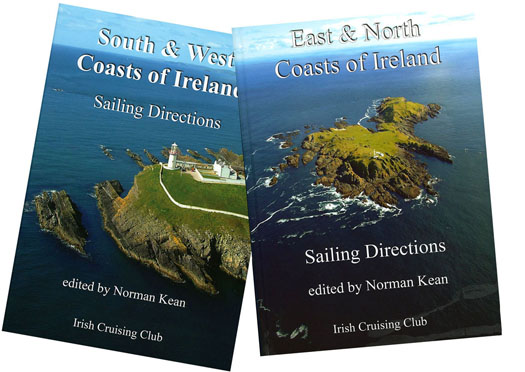
ICC SDs are available from chandlers and booksellers, and are distributed in Great Britain and the rest of the world by Imray, and in Ireland by Todd Chart Services. East and North Coasts Directions ISBN 978 0 9558 199 1 9; South and West Coasts Directions ISBN 978 0 9558 199 2 6.
Craftinsure Sponsor Royal St. George Junior Event
Dun Laoghaire's Royal St. George Yacht Club has announced that its inaugural Junior Spring Open, sponsored by Craftinsure, will be held on the 19th & 20th of March 2011. This event promises to be a great kick start to the Junior Sailing Season for the Optimist, 420, Feva and Laser Classes.
There will be both Regatta and Main Fleets, Regatta Coaches on the courses and the event will count as an Optimist Pre-Trials and Pre-Regional event. With the ISA Mitsubishi Youth National Championship being held in the same sailing area at the end of April, this event is a great opportunity for sailors from all around the country to get some practise in the local waters.
There will be entertainment for sailors and parents on both evenings, evening dinners and, of course, full Six Nations Rugby coverage on the Saturday throughout the Club. There will also be live-tweeting from the water throughout the event - follow this live action unfold at www.twitter.com/rsgyc.
For further information and to enter online please visit www.rsgyc.ie. The Entrance Fee is €85 for Fevas & 420s and €55 for Oppies & Lasers.
Solo Sailing Conference Offers Charter of Performance Yachts
Irish solo sailing fans may be interested in the annual Solo Racing Festival at the Royal Southern Yacht Club, Hamble on Saturday 12th March.
Given the Figaro race is coming to Dun Laoghaire in August a talk on the Artemis Academy with John Thorn (Figaro 2) will be of particular interest.
Owen Clarke's designer Merfyn Owen, who lives in Hamble will be attending as well as colleagues from their brokerage partners Boatshed Performance.
So whether your interest be solo sailing or short-handed sailing in general they will be there to answer questions on design, construction, as well as sale/purchase and charter of offshore performance yachts.
The Race Fair is an open house from 10.00 for race organisers to meet and greet potential skippers from; Global Ocean/Class 40, Mocra, UK mini group, RORC, SORC, Biscay Challenge, AZAB. Floating boat show, 8 boats including the OC class 40, 2 minis, A35, J105, Figaro 2, Sunfast 3200.
There is a Book Signing, Alex Bennett signing copies of High Seas High Stakes and showing Fuji DVD Mike Golding is opening the talks at 11,00.
Followed by:
Winning Mind Set with Ian Brown, sports psychologist
Global Ocean race with Oliver Dewar
Two Star/Ostar with John Lewis, RWYC
30m trimaran design with Nigel Irens (Idec, Sodebo)
Artemis Academy first term report with John Thorn (Figaro 2)
Route du Rhum with Marco Nannini, (class 40)
all in the spendid riverside setting of the Royal Southern Yacht Club, Hamble.
More HERE.
Strong Winds for Kinsale League
With the Laser Fleets not launching until the last minute, they however mistimed the 11.55 First Gun. After a short postponement, the Squib Class who had been reveling in the pre-start conditions was the first fleet to compete. The strong winds persisted throughout the first race with each squall prompting a flurry of capsizing Lasers as one Squib got into difficulties against the lee shore at Jarley's Cove. As the winds moderated to a force five, with the slackening tide and a calmer sea the remaining two races enjoyed easier if still challenging conditions. The decision to combine the three Laser fleets into one start, and the Squibs with the Mixed Dinghies led to the better management of the last two races given the conditions.
The previously unassailable form of Marcus Hutchinson (KYC) helming 'Sensation', was put under greater pressure in the Squib Fleet, with Victor Fusco and crew James Bendon (KYC) on Gemini notably claiming a first place in the second race. However with his crew Ben Fusco, Marcus took line honours in the other two races bringing his total of wins to five out of a possible six; as two discards now apply. Realistically, with next Sunday being the final day of racing and with eight points behind the leader, Gemini will be hoping to secure the second place overall. With a second in the first race adding to his overall score, he is now just two points ahead of the consistent Colm Dunne and Mark Buckley (KYC) who have moved up a place aided by an excellent second in the third race. Having an unsuccessful day due to a sixth in the first race and not completing the last two, Paul McCarthy (KYC) in Mack drops two places to a fourth overall. On only one point adrift he is still very much in contention for a top three placing.
In the Laser Standard Class Rob Howe (RCYC), though obviously comfortable in the strong breeze, did not quite repeat last week's clean sweep of wins. Nevertheless, with one second and two firsts he retains his overall position in the fleet on seven points overall. David Kenefick (RCYC) took advantage by winning the first race, and his subsequent two seconds puts him on just two points behind the leader going into the final day next Sunday. Having now discarded his worst two scores due to missing the first race day, Paul O' Sullivan (RCYC) continued his consistent form with a further three thirds, and is now in third place overall.
Eoin Keller (LDYC), the previous clear leader in the Laser Radial Class and unable to compete this week, slips dramatically from a total of four points to fifteen points and into second place overall. Eoghan Cudmore (KYC) with a splendid second and two wins on Sunday leaps from third into first place overall. Sean Murphy (KYC) who scored a third and two seconds positions himself just one point behind Keller. With very little between the top three, it will take the remaining races to decide final outcome.
Due to other sailing commitments for the young Laser 4.7 fleet, there has been much changing in the league position over the past few weeks; apart from Cian Byrne (KYC/RCYC) who has resolutely held onto the top position from day one. A close and exciting tussle has finally emerged between Cian and Dara O'Shea (KYC), who despite being on the wrong side of a protest decision in the first race, recovered well to gain a subsequent second and first. He has given himself a chance being well positioned just three points behind overall. Conor Murphy (KYC) with an excellent day's achievement of a first and two seconds has shot up the league table into third place overall.
Brian Jones and Gary Frost (MBSC) in their 505 continued unchallenged with a further three bullets in the Mixed Dinghy Class, with the Fevas of David Marshall/Rob Scandrett and Fiona Lynch/Sofie Kelleher in second and third overall.
The ASM Frostbite League at KYC will be completed next Sunday, 27th February 2011. First Gun is at 11.55 a.m.



























